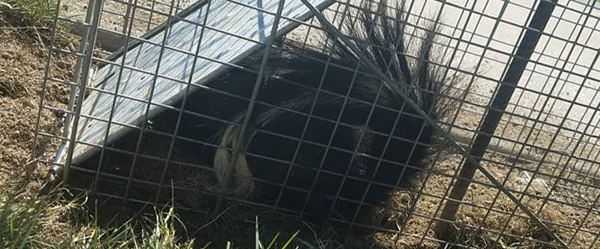- info@wildlife-removal.com
Call us for help in your town
Wildlife Removal Education
What should I do with a skunk after I catch it?
Need skunk removal in your hometown? We service over 500 USA locations! Click here to hire us in your town and check prices - updated for year 2020.
At this point, you have likely had it up to your teeth with the skunks in the yard and you have decided to do something about it… finally.

While trapping is one of the best ways to get rid of your resident skunks, you must be prepared for the eventuality of what to do with it once caught in your trap. In fact, it is important that you make this decision before setting the trap, so that the animal is not inhumanely kept in your cage for an extended period while you try to figure out your next steps.
After trapping a skunk successfully, the following options are available for you to choose from:
Kill it
You may kill a trapped skunk by shooting or euthanizing it. Shooting a skunk seems simple enough, but there’s the matter of the animal’s blood, which may have been contaminated with rabies and other zoonotic infections. These diseases are transferable to humans that are exposed to the blood of rabid animals.
Relocate It
Retrieve the successful trap and avoid getting sprayed by holding out a large, old towel or sheet in front of you as you approach the trap. Skunks don’t usually spray if they cannot see their target. Approach the trapped skunk calmly without any sudden movement to avoid startling it. You can even hum softly. Once within reach, drape your towel over the cage.
Carry the trapped animal several miles away from your property, preferably to a woody area and release it there. Cover yourself completely with heavy clothing and gloves while on this mission. The skunk may have become agitated at this point. They mostly leave the traps calmly but it’s best to take these precautions in case it decides to spray.
Note: Never release a skunk that you suspect of being rabid, that is showing signs of aggression, very nervous activity or salivation. Look out for signs like circling movements, disorientation, limb weakness, unusual boldness or unusual tameness. Take this skunk to your local animal department for rabies testing, and possible elimination.
Also note that skunk control activities are often guided by state or county-specific regulations, so you would do well to check up on what is allowed in your locality before deciding on any of these options.
Go back to the Skunk Removal page.
Skunk relocation distance: The ideal relocation distance for animals is at least five miles. If you can travel ten miles away, that’s even better. Whenever you select a relocation area for your skunk, make sure it has proper coverage, a water supply, and is not in an area where other homes could be easily invaded. If you can’t find one of these locations, your best option is to have a professional take care of the skunks. Wildlife removal companies often have tried and true relocation areas, and if not, they have humane ways of dealing with a skunk. Transportation can also be tricky. As long as you cover the cage, the skunk should not be too panicked by the time you arrive at the destination. The cover will also prevent the skunk from spraying unless the animal is very young and doesn’t have good control of its sprayer. It takes a skunk a long time to rebuild the liquid in that scent gland, and the animal won’t use it unless it sees a target. Transporting the skunk in a truck would be ideal; a car will hold on to the odor for a very long time.


















